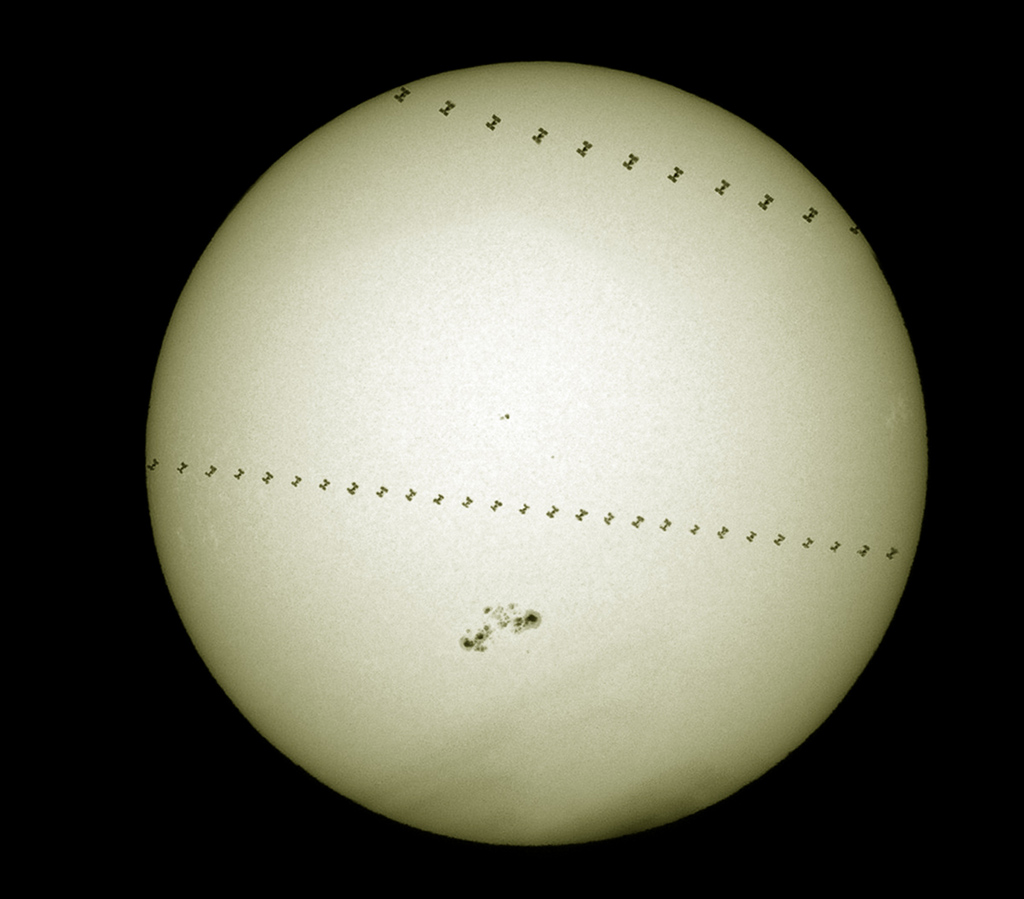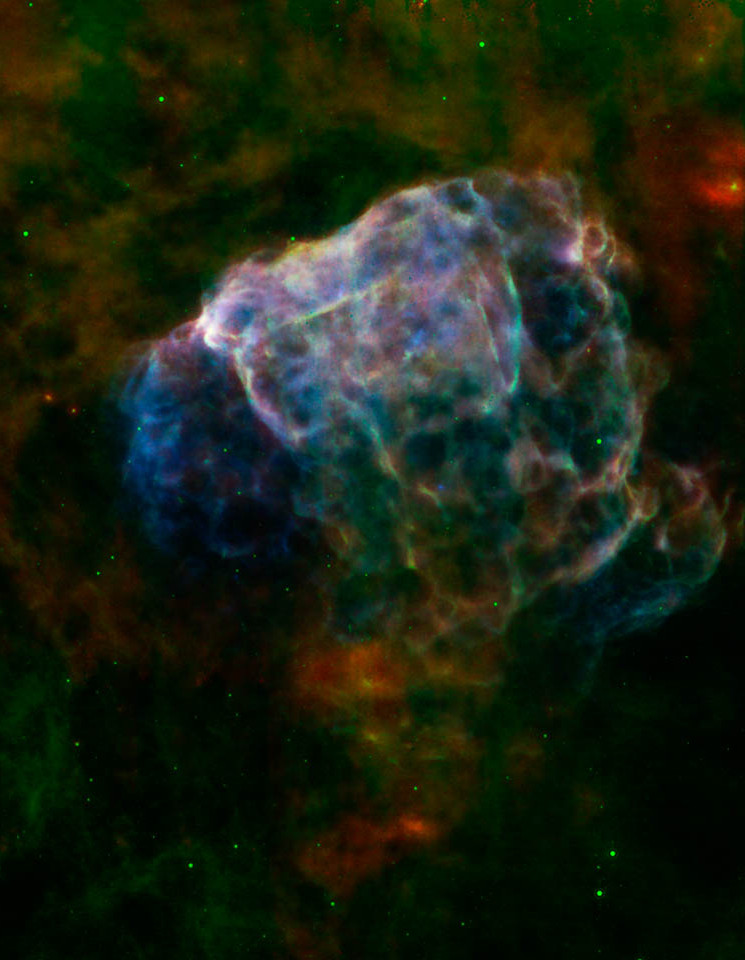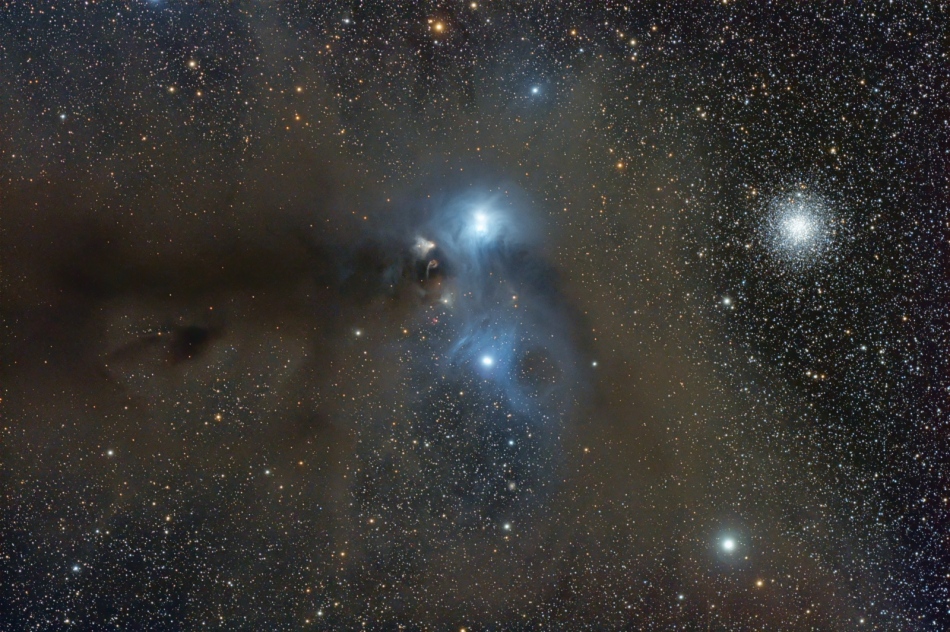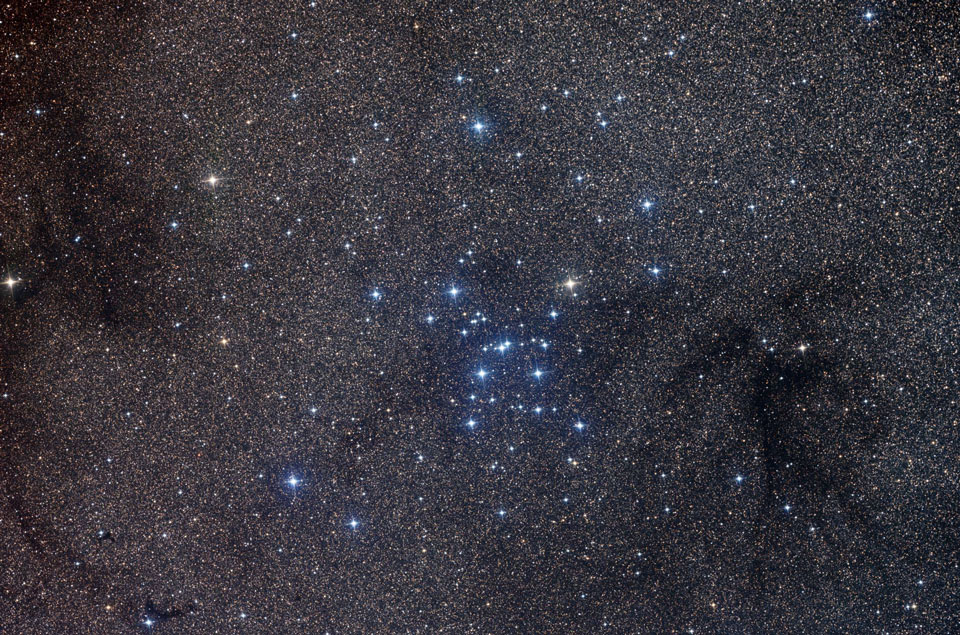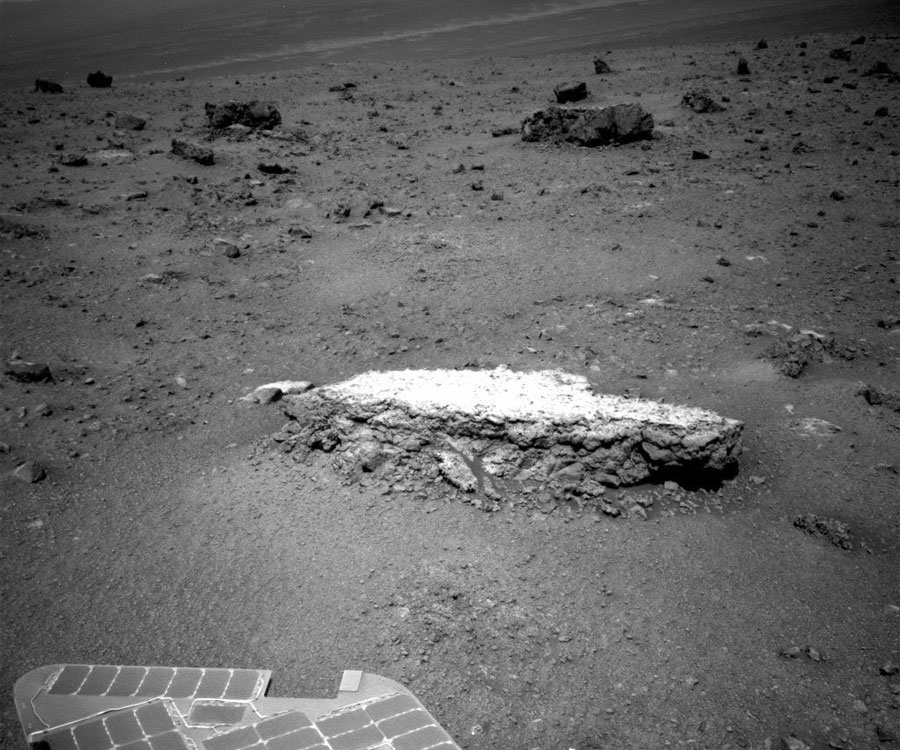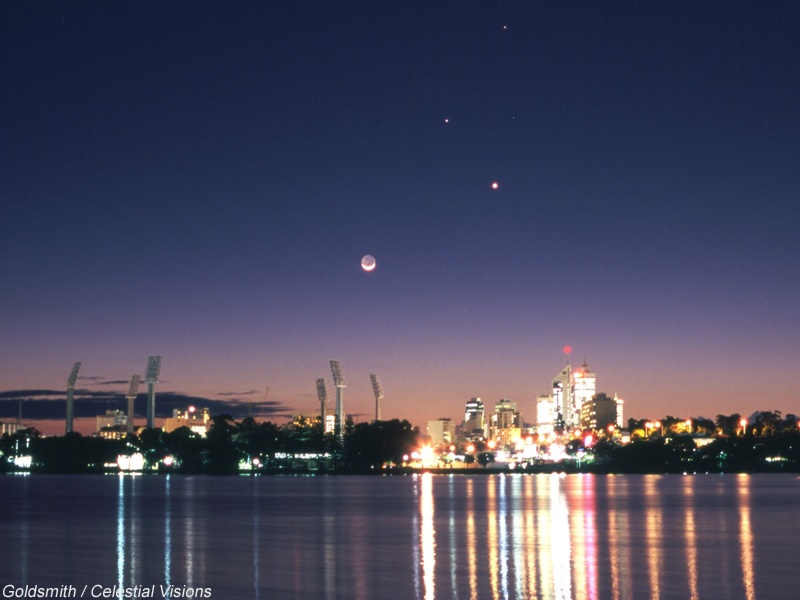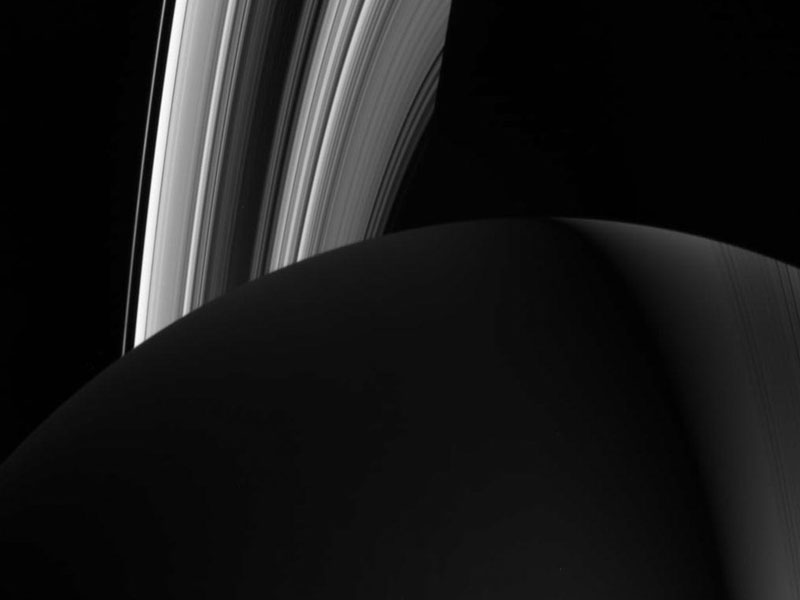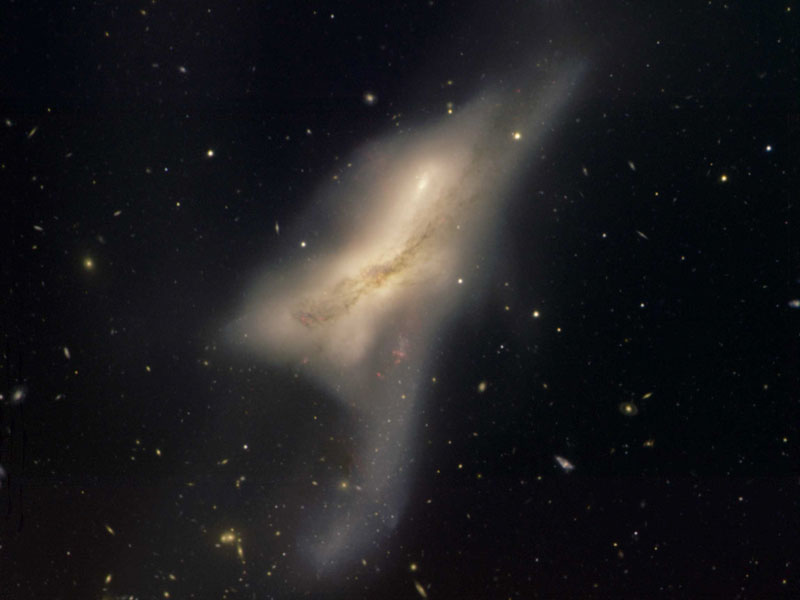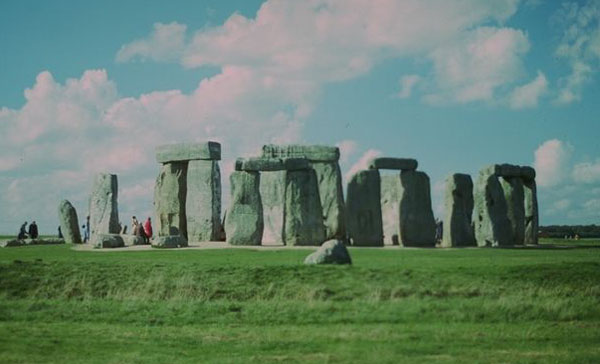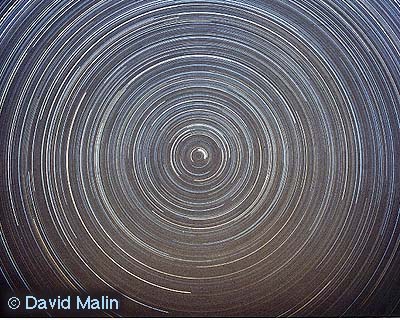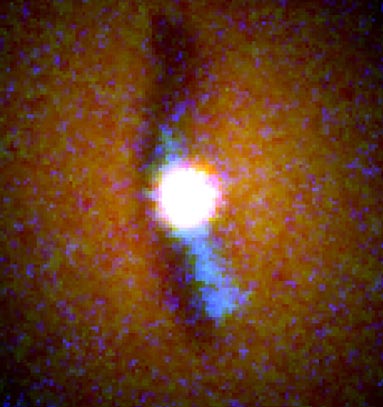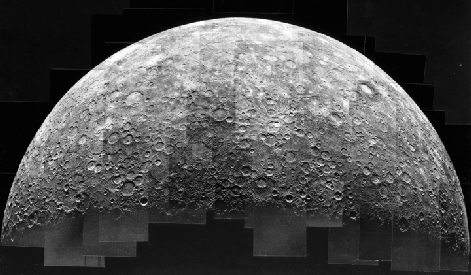| << Previous | Index | Next >> |
2015 Not once, but twice the International Space Station transits the Sun on consecutive orbits of planet Earth in this video frame composite. The scene was captured on August 22 from a single well-chosen location in Schmalenbeck, Germany where the ISS created intersecting shadow paths only around 7 kilometers wide. Crossing the solar disk in a second or less, the transits themselves were separated in time by about 90 minutes, corresponding to the space station's orbital period. while the large, flare-producing sunspot group below center, AR 2043, remained a comfortable 150 million kilometers away, the distance between camera and orbiting station was 656 kilometers for its first (upper) transit and 915 kilometers for the second more central transit. In remarkably sharp silhouette, the ISS is noticeably larger in angular size during the closer, first pass. Of course, tomorrow the Moon will transit the Sun. But even at well-chosen locations, its dark, central shadow just misses the Earth's surface creating a partial solar eclipse.
2014
2013 Cosmic dust clouds sprawl across a rich field of stars in this sweeping telescopic vista near the northern boundary of Corona Australis, the Southern Crown. Less than 500 light-years away the dust clouds effectively block light from more distant background stars in the Milky Way. The entire frame spans about 2 degrees or over 15 light-years at the clouds' estimated distance. Near center is a group of lovely reflection nebulae cataloged as NGC 6726, 6727, 6729, and IC 4812. A characteristic blue color is produced as light from hot stars is reflected by the cosmic dust. The dust also obscures from view stars in the region still in the process of formation. Smaller yellowish nebula NGC 6729 surrounds young variable star R Coronae Australis. Below it are arcs and loops identified as Herbig Haro objects associated with energetic newborn stars. Magnificent globular star cluster NGC 6723 is at the right. Though NGC 6723 appears to be part of the group, its ancient stars actually lie nearly 30,000 light-years away, far beyond the young stars of the Corona Australis dust clouds.
2012 M7 is one of the most prominent open clusters of stars on the sky. The cluster, dominated by bright blue stars, can be seen with the naked eye in a dark sky in the tail of the constellation of the Scorpion (Scorpius). M7 contains about 100 stars in total, is about 200 million years old, spans 25 light-years across, and lies about 1000 light-years away. The above deep exposure was taken from Hakos Farm in Namibia. The M7 star cluster has been known since ancient times, being noted by Ptolemy in the year 130 AD. Also visible are a dark dust cloud and literally millions of unrelated stars towards the Galactic center.
2011 Why does this Martian rock have so much zinc? Roughly the size and shape of a tilted coffee-table, this oddly flat, light-topped rock outcropping was chanced upon a few weeks ago by the robotic Opportunity rover currently rolling across Mars. Early last month Opportunity reached Endeavour crater, the largest surface feature it has ever encountered, and is now exploring Endeavour's rim for clues about how wet Mars was billions of years ago. Pictured above and named Tisdale 2, the unusual rock structure was probed by Opportunity last week and is now thought to be a remnant thrown off during the impact that created nearby Odyssey crater. The resulting chemical analysis of Tisdale 2, however, has shown it to have a strangely high amount of the element zinc. The reason for this is currently unknown, but might turn out to be a clue to the history of the entire region. Opportunity is already finding rocks older than any previously studied and will continue to explore several other intriguing rock formations only now glimpsed from a distance.
2010 The remnants of nuclear reactors nearly two billion years old were found in the 1970s in Africa. These reactors are thought to have occurred naturally. No natural reactors exist today, as the relative density of fissile uranium has now decayed below that needed for a sustainable reaction. Pictured above is Fossil Reactor 15, located in Oklo, Gabon. Uranium oxide remains are visible as the yellowish rock. Oklo by-products are being used today to probe the stability of the fundamental constants over cosmological time and distance scales and to develop more effective means for disposing of human-manufactured nuclear waste.
2009 This serene view records a late summer night sky over the rolling, green hills of planet Earth. It was taken near the rural village of Saadat Shahr, Fars province, in southern Iran. Saadat Shahr is also known as Astronomy Town, as the inhabitants have demonstrated a remarkable passion for sky gazing. Fittingly, this Astronomy Town sky view finds a lovely part of the Milky Way near picture center. The three brightest stars are the stars of the Summer Triangle, Deneb in Cygnus (top), Altair in Aquila (left), and Vega in Lyra (right). The foreground landscape, illuminated by Astronomy Town lights, includes a kind of wild pistachio tree common in the region. To identify the stars and constellations, just slide your cursor over the image.
2008 A bright trio of terrestrial planets was joined by a young Moon on September 1st, in planet Earth's early evening skies. In this view of the celestial gathering from Perth, Western Australia, the Moon's sunlit crescent is nearly horizontal at Perth's southern latitude of about 32 degrees. Venus, then Mercury, and finally Mars shine above colorful city lights on the far shore of the Swan River. The six unlit towers on the left surround a large cricket stadium. For now, the planetary trio still lingers low in the west just after sunset. But in the coming days Venus will move farther from the Sun, climbing higher after sunset, while Mercury and Mars will steadily sink into the glare along the western horizon.
2007 Have you ever seen six rainbows at once? They are not only rare to see -- they are a puzzle to understand. The common rainbow is caused by sunlight internally reflected by the backs of falling raindrops, while also being refracted at the air / water boundary. To see a rainbow, look opposite the Sun towards a rainstorm. This primary rainbow is the brightest color swath in the above image. Multiple internal reflections inside water droplets sometimes make a secondary rainbow to become visible outside the first, with colors reversed. Just such a secondary rainbow is visible of the far left. Harder to explain is the intermediate rainbow, between the two. This rainbow is likely caused by sunlight that has first reflected off the lake before striking the distant raindrops that is reflecting sunlight back toward the observer. Each of these rainbows appears to be reflected by the calm lake, although because the positions of rainbows depend on the location of the observer, a slightly displaced image of each rainbow is actually being imaged.
2006 This is what Saturn looks like at night. In contrast to the human-made lights that cause the nighttime side of Earth to glow faintly, Saturn's faint nighttime glow is primarily caused by sunlight reflecting off of its own majestic rings. The above image of Saturn at night was captured in July by the Cassini spacecraft now orbiting Saturn. The above image was taken when the Sun was far in front of the spacecraft. From this vantage point, the northern hemisphere of nighttime Saturn, visible on the left, appears eerily dark. Sunlit rings are visible ahead, but are abruptly cut off by Saturn's shadow. In Saturn's southern hemisphere, visible on the right, the dim reflected glow from the sunlit rings is most apparent. Imprinted on this diffuse glow, though, are thin black stripes not discernable to any Earth telescope -- the silhouetted C ring of Saturn. Cassini has been orbiting Saturn since 2004 and its mission is scheduled to continue until 2008.
2005 Is this one galaxy or two? The jumble of stars, gas, and dust that is NGC 520 is now thought to incorporate the remains of two separate galaxies. A combination of observations and simulations indicate the NGC 520 is actually the collision of two disk galaxies. Interesting features of NGC 520 include an unfamiliar looking tail of stars at the image bottom and a perhaps more familiar looking band of dust running diagonally across the image center. A similar looking collision might be expected were our disk Milky Way Galaxy to collide with our large galactic neighbor Andromeda (M31). The collision that defines NGC 520 started about 300 million years ago and continues today. Although the speeds of stars are fast, the distances are so vast that the interacting pair will surely not change its shape noticeably during our lifetimes. NGC 520, at visual magnitude 12, has been noted to be one of the brightest interacting galaxies on the sky, after interacting pairs of galaxies known as the Antennae. NGC 520 was imaged above in spectacular fashion by the Gemini Observatory in Hawaii, USA. Also known as Arp 157, NGC 520 lies about 100 million light years distant, spans about 100 thousand light years, and can be seen with a small telescope toward the constellation of the Fish (Pisces).
2004 Mercury's surface looks similar to our Moon's. Each is heavily cratered and made of rock. Mercury's diameter is about 4800 km, while the Moon's is slightly less at about 3500 km (compared with about 12,700 km for the Earth). But Mercury is unique in many ways. Mercury is the closest planet to the Sun, orbiting at about 1/3 the radius of the Earth's orbit. As Mercury slowly rotates, its surface temperature varies from an unbearably cold -180 degrees Celsius to an unbearably hot 400 degrees Celsius. The place nearest the Sun in Mercury's orbit changes slightly each orbit - a fact used by Albert Einstein to help verify the correctness of his then newly discovered theory of gravity: General Relativity. The above picture was taken by the only spacecraft ever to pass Mercury: Mariner 10 in 1974. A new mission, Messenger, launched for Mercury last month and is scheduled to enter orbit around the Solar System's innermost planet in in 2011.
2003 A truly enormous collection of thousands of galaxies, the Perseus Cluster - like other large galaxy clusters - is filled with hot, x-ray emitting gas. The x-ray hot gas (not the individual galaxies) appears in the left panel above, a false color image from the Chandra Observatory. The bright central source flanked by two dark cavities is the cluster's supermassive black hole. At right, the panel shows the x-ray image data specially processed to enhance contrasts and reveals a strikingly regular pattern of pressure waves rippling through the hot gas. In other words, sound waves, likely generated by bursts of activity from the black hole, are ringing through the Perseus Galaxy Cluster. Astronomers infer that these previously unknown sound waves are a source of energy which keeps the cluster gas so hot. So what note is the Perseus Cluster playing? Estimates of the distance between the wave peaks and sound speed in the cluster gas suggests the cosmic note is about 57 octaves below B-flat above middle C.
2002 In 1572, Danish astronomer Tycho Brahe recorded the sudden appearance of a bright new star in the constellation Cassiopeia. The new star faded from view over a period of months and is believed to have been a supernova, one of the last stellar explosions seen in our Milky Way galaxy. Now known as Tycho's Supernova Remnant, the expanding debris cloud is shown in this detailed false-color x-ray image from the orbiting Chandra Observatory. Represented in blue, the highest energy x-rays come from shocked regions along the outer edges of the supernova remnant, corresponding to gas at temperatures of 20 million degrees Celsius. X-rays from cooler gas (only 10 million degrees or so!) dominate the remnant's interior. Unlike some other supernova remnants, no hot central point source can be found, supporting the theory that the origin of this stellar explosion was a runaway nuclear detonation that ultimately destroyed a white dwarf star. At a distance of about 7,500 light-years, Tycho's Supernova Remnant appears to be nearly 20 light-years across. This x-ray picture's field of view slightly cuts off the bottom of the generally spherical cloud.
2001 An unusual triangle of light will be particularly bright near the eastern horizon before sunrise during the next two months for observers in Earth's northern hemisphere. Once considered a false dawn, this triangle of light is actually Zodiacal Light, light reflected from interplanetary dust particles. The triangle is clearly visible on the left of the above frame taken from Mauna Kea in Hawaii on August 30 by one of the developing global network of fisheye nighttime web cameras called CONCAMs. Zodiacal dust orbits the Sun predominantly in the same plane as the planets: the ecliptic. Indeed, the triangle points to bright spots Jupiter and Saturn, with Saturn nearer the center. Zodiacal light is so bright this time of year because the dust band is oriented nearly vertical at sunrise, so that the thick air near the horizon does not block out relatively bright reflecting dust. Zodiacal light is also bright for people in Earth's northern hemisphere in March and April just after sunset.
2000 If you could have hovered above the Pathfinder mission to Mars in 1997, this is what you might have seen. Directly below you is the control tower of Sagan Memorial Station. Three dark solar arrays extend out to collect valuable energy, surrounded by light-colored deflated airbags that protected Pathfinder's instruments from directly colliding with the rocky Martian surface. The left solar panel has ramps down which Pathfinder's rolling robot Sojourner started its adventure to nearby rocks. Sojourner itself is visible inspecting a rock nicknamed Yogi at 11 o'clock. Rocks cover the Martian surface, with Twin Peaks visible on the horizon at 9 0'clock. The distant sky is mostly orange. This image is a recently released digital combination of panoramic pictures taken by Pathfinder on Mars and a picture of a Lander scale model back on Earth. The Mars Pathfinder Mission was able to collect data for three months, sending back information that has indicated a wet distant past for Mars.
1999 Stonehenge consists of large carved stones assembled about 4000 years ago. Long before modern England was established, ancient inhabitants somehow moved 25 ton rocks nearly 20 miles to complete it. From similar constructs of the era, people could learn the time of year by watching how the Sun and Moon rose and set relative to accurately placed stones and pits. The placement of the boulders at Stonehenge, however, is not impressively accurate by today's standards, nor even by the standards of that time. Therefore, modern scholars interpret Stonehenge as a colossal monument to the Sun in celebration of the predictability of the seasons.
1998 As the Earth spins on its axis, the sky seems to rotate around us. This motion produces the beautiful concentric trails traced by the stars in this time exposure of the night sky. In the middle of the picture is the North Celestial Pole (NCP), easily identified as the point in the sky at the center of all the star trail arcs. The very short bright trail near the NCP was made by the star Polaris, commonly known as the North Star.
1997 Something is lighting up the center of galaxy NGC 6251. Leading speculation holds that it is a large black hole not shrouded by gas and dust typically found near the center of a galaxy. Observations taken with the Hubble Space Telescope and released earlier this week indicate a new perspective on the strange beasts that rule the centers of galaxies: a bright central object that is illuminating a surrounding material disk, shown in blue. The lack of reflection from the upper part of the disk indicates that this disk is warped in shape. Although not visible in the above composite image, a huge plasma jet streams out from the central object, perpendicular to the warped disk.
1996 Mercury's surface looks similar to our Moon's. Each is heavily cratered and made of rock. Mercury's diameter is about 4800 km, while the Moon's is slightly less at about 3500 km (compared with about 12,700 km for the Earth). But Mercury is unique in many ways. Mercury is the closest planet to the Sun, orbiting at about 1/3 the radius of the Earth's orbit. As Mercury slowly rotates, its surface temperature varies from an unbearably cold -180 degrees Celsius to an unbearably hot 400 degrees Celsius. The place nearest the Sun in Mercury's orbit changes slightly each orbit - a fact used by Albert Einstein to help verify the correctness of his then newly discovered theory of gravity: General Relativity. The above picture was taken by the only spacecraft ever to pass Mercury: Mariner 10 in 1974.
1995
| << Previous | Index | Next >> |
